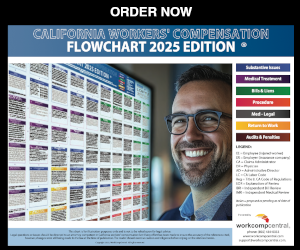Industry Insights
May 22, 2017
Sams: Formularies Grow in Popularity, but Which One to Use?
- National
- - 1 share
A familiar labor vs. management battleground has sprung around the latest cost-control trend in workers’ comp: drug formularies.

Jim Sams
Some media reports portray formularies as a means of combating opioid abuse. The Associated Press reported that under a Louisiana formulary bill, workers “would have a tougher time getting opioids” in a state with the seventh-highest opioid and benzodiazepine sedative prescription rate in the U.S. Labor says insurers are just trying to cut costs.
In New York, the coverage focused mainly on potential cost savings in the nation’s third-most expensive comp system. Critics bemoaned state regulations that take decisions away from doctors.
There’s nothing misleading about either approach. The press tends to focus on the most topical angle.
But the coverage so far has missed an aspect that likely has far more relevance to the workers’ compensation industry. That is, in addition to the question of whether to adopt a formulary, there’s the question of which formulary to adopt.
That issue spawned a war of words in the professional columns section of WorkCompCentral last week.
The Reed Group’s governmental affairs manager, Carlos Luna, took the first swipe last Monday with an assertion that the Work Loss Data Institute’s Official Disability Guidelines formulary was not developed with the same academic rigor as the formulary written by the American College of Occupational and Environmental Medicine. The Reed Group bought publishing rights for the ACOEM formulary and its treatment guidelines in 2013, and made it a part of its MDGuidelines product.
WLDI shot back in a rebuttal by ODG Managing Director Phil LeFevre on Tuesday. His main point was that it is hard to argue with success: The ODG formulary (actually Appendix A to the company’s treatment guidelines) has been adopted by Ohio, Texas, Oklahoma, Arizona and Tennessee, with results proven by research. Fewer injured workers using opioids. Lower costs. LeFevre argued that Reed Group’s “misleading and inaccurate” negativity harms the evidence-based medicine movement.
Texas Workers’ Compensation Commissioner Ryan Brannan joined the fray in a column posted Wednesday. While not mentioning ODG specifically, he said “our formulary” has been a “resounding success” that ensures injured workers do not get excessive or unnecessary prescriptions.
The disagreement between the Reed Group and the Work Loss Data Institute revolves mainly around an issue only a wonk could love: the standards set by the National Guideline Clearinghouse.
The clearinghouse, administered by the federal Agency for Healthcare Research Quality, implemented six strict criteria for inclusion of clinical practice guidelines in 2014.
ODG does not meet that criteria, which were developed by the Institute of Medicine. Work Loss Data Institute does not state how it selected the various clinical studies it uses to determine best treatment practices, or the criteria it uses to determine the importance of those studies. WorkCompCentral’s medical and business reporter, Elaine Goodman, reported on this last June.
WLDI says exclusion from the clearinghouse is no big deal. ODG is continuously updated, so it doesn’t fit a review process that can take years. That is why other commercial guidelines, such as those published by McKesson and Milliman, aren’t included in the clearinghouse, either.
Of course, Reed Group disagrees and touts ACOEM’s formulary as the only one built on rigorous academic research with a transparent methodology. While ODG is a simple list of drugs listed as either “yes” or “no,” the ACOEM formulary recommends drugs not only according to the diagnosis but according to the stage of the condition, whether chronic, acute or sub-acute. Where evidence is lacking, ACOEM offers no recommendation at all.
Maybe simplicity sells. ODG has been on a roll with state legislatures around the country since the Texas Legislature mandated its adoption in 2007. Tennessee, Oklahoma and Arizona followed.
Louisiana lawmakers introduced two formulary bills this year; one would require the use of ODG, and the other leaves that choice to regulators. But it is the ODG bill that has moved toward a vote on the House of Representatives floor. It remains to be seen whether the Republican-majority Legislature can get the bill past Democrat governor John Bel Edwards, a former plaintiff’s attorney.
Reed Group, a relative newcomer in the formulary field, has had less success. Nevada quietly adopted ACOEM in 2015 and sang the praises of its “rigorous strength-of-evidence rating system” in this newsletter.
I say quietly because WorkCompCentral missed that story, as did the rest of the media. And “adopted” may be too strong a word because Nevada’s guidelines are voluntary for payers.
But the California Division of Workers’ Compensation will likely give the Reed Group a more clear victory by basing its proposed formulary entirely on ACOEM. Mark Pew, senior vice president for managed-care provider Prium, told WorkCompCentral’s Greg Jones in March that the ACOEM-based formulary is “unique to California.”
Leave it to California to be unique. I suspect that politics plays a role on which formulary is chosen. All of the state legislatures that have adopted ODG are controlled by Republicans. California is most definitely not.
Two big blue states joined the formulary movement in recent months. The New York Legislature directed the State Workers’ Compensation Board to adopt a formulary as part of a budget bill passed in April. In Illinois, Democratic lawmakers have proposed a formulary as part of a “grand bargain” to break a two-year budget stalemate.
Both the New York and Illinois legislation leave it up to regulators to decide which formulary to use. With a Jan. 1 deadline in the budget bill, New York is going to have to act fast. Whether Illinois ever passes a work comp reform bill remains to be seen.
In the meantime, I’m curious to see if a pattern develops. Will work comp pharmaceutical management develop into a two-formulary system — one for red states and one for blue?
Jim Sams is senior editor for WorkCompCentral.
Advertisements
Columns
- CAAA: Fireworks Warehouse Blast Exposes Flaws in Safety, Oversight, Accountability 07/16/25
- Gelman: Asbestos Ban Is a Win for Workers 07/14/25
- Snyder: Mediation Confidentiality 07/11/25
- Snyder: Settle and Sue: Don't Let It Happen to You 07/09/25
- Kamin: State Senate Committee to Consider SIBTF Bill 07/07/25
- Anders: Self vs. Professional MSA Administration: Which Is Right for the Injured Worker? 06/30/25
- Geaney: Court Affirms Finding of Police Officer's Joint Employment 06/27/25
- Fricker: A New Era for Comp Subrogation 06/25/25
- Kamin: AI for HR Equals Bad Injury Reporting 06/20/25
- Montgomery: Will DWC Ignore New Law? 06/18/25
- Kamin: 4th DCA Clarifies DOI From Date of Knowledge 06/16/25
- Wade: Are the Old Ways Gone? 06/13/25
- Snyder: Trust Your Intuition 06/12/25
- Montgomery: DIR Director Reportedly Resigning 06/11/25
- Gelman: Supreme Court to Review COVID Compensability 06/06/25
- Paduda: WCRI's New Studies 06/05/25
- Moore: 187 Pages of WCRI State Stats 06/02/25
- Paduda: The Gutting of NIOSH 05/30/25
- CAAA: Left in the Smoke 05/28/25
- Gelman: Intentional Wrong? 05/27/25
Now Trending
- Workers' Compensation News
-
Calif. LAO: Second
Injury Fund 'No Longer Aligned'
With Legislative…
Posted on Jul 14, 2025
-
Calif. City Sues
Ex-Cop Accused of Comp…
Posted on Jul 11, 2025Michael Hemming says: “Back when I handled criminal defense I represented a few clients accused…”
-
Calif.
Commissioner Approves 8.7% Rate
Increase, First Since…
Posted on Jul 15, 2025
-
Calif. CWCI: Data
Doesn't Support Presumption for
Hospital…
Posted on Jul 9, 2025
-
Calif. Committees
Pass Presumption, SIBTF…
Posted on Jul 11, 2025
-
Calif. QME Exam
Scheduled for…
Posted on Jul 16, 2025
-
Calif. WCIRB Posts
Agenda for 2025…
Posted on Jul 11, 2025
-
R.I. Split Supreme
Court Upholds Grant of Duty
Disability Pension for State…
Posted on Jul 16, 2025
-
Miss. Truck Driver
Found Dead in Cab, but Family
Doesn't Get…
Posted on Jul 11, 2025
-
Mont. Fire
Marshal's Claim Survives State
Fund's Bid for Summary…
Posted on Jul 10, 2025
Jobs
Upcoming Events
Sep 2-4, 2025
San Diego Elevate Workers' Com
We are thrilled to announce that Early Bird registration is OPEN for ELEVATE« 2025! This year's …
Social Media Links
c/o Business Insurance Holdings, Inc.
Greenwich, CT 06836




No Comments
Log in to post a comment